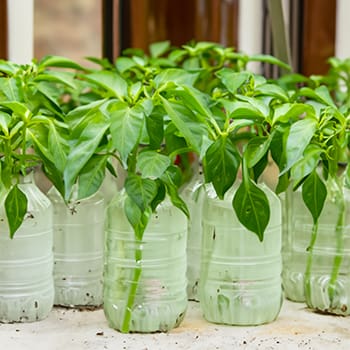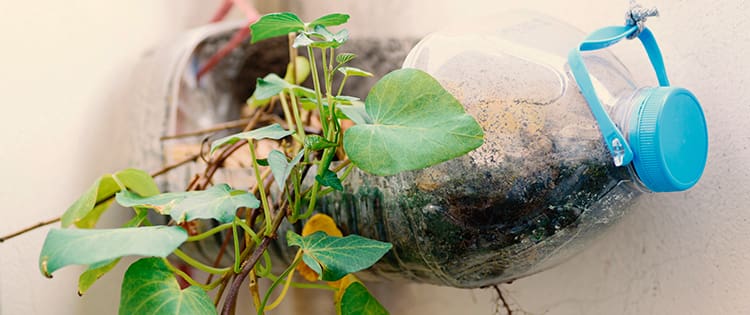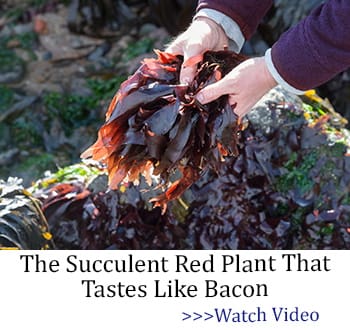So, you’ve decided that chaos is the right path for you and you want to make a garden out of all those water bottles that you’re using on a day-to-day basis at work. I’ll tell you what; I’m right there with you on this one.
Let’s see what we can do to recycle some of these bottles. Please note that I only recommend using bottles that are clear, will not project light on flammable surfaces, and that are completely food-safe. Though I can’t fathom a situation in which a bottle you’re drinking from is food-safe, the lawyers like it when I cover all the bases. Let’s get started.
Pint Bottles
You won’t be growing a lot with these, but you can certainly do some smaller plants. My suggestions? Use pint bottles (such as your average Mt. Dew bottle) as plant starters rather than full-time planters. These rarely wear down and you’ll get a ton of seasons of use out of them.
Cut the top off the bottle, saving it to use as a funnel for other projects down the road. Trust me, you can never have enough funnels. Poke several holes in the bottom of the bottle, about 1/8th” to 1/4″ around to use as drainage holes. Fill with potting or planting mix and use as a fantastic seed starting area.
Determined to grow in a 16 to 20 oz bottle? You’ll be looking at dwarf pepper plants, vine beans, vine peas, and dwarf varieties of greens. They also make a really nice plot for alfalfa sprouts and microgreens, if the top is removed. Interested in something with a little kick that isn’t a pepper? Try green onions. Most green onions will sprout in almost anything, so long as they have an inch or two of soil to root in.
Quart Bottles
These are your average 1-3 liter bottles of soda, and this will encompass a pretty wide variety of plants. Can you grow watermelons of this size? Sure, if you’re willing to lay the bottles long-side down against the ground. No problem.
The question is, should you?
At this size, you can grow almost anything you’d grow in your average 4 to 8-qt container, though I would recommend you stay on the lower side of things. Small flowers and herbs are easily grown in these sizes, along with a wide variety of vegetables.
The biggest problem with these is that the plastic often begins insulating the water within the soil. You can freeze or boil your plants alive, accidentally, by using these (and larger cavities) as planters.
How do you avoid this? You’ll need drainage holes starting 3 inches below the top of the soil and continuing down around the bottom of the container. Even if you’re underwatering there’s still a good chance of problems happening because these materials lack the porous nature of typical planters (such as terra cotta).
Gallon and Near-ish Sizes
Have a few gallons of water sitting around and you don’t know what to do with the empty bottles? Maybe they’re milk jugs that you just can’t bear to part with.
Again, make sure you have significant drainage holes from a few inches below the top of the soil all the way down to the bottom of your container. Without those, you’ll have a soggy mess no matter what you’re doing.
Successful plants for this size tend to include bush beans, cucumbers, and even some squash. You don’t want to go all out on a huge zucchini or pumpkin plant, but a butternut squash is happy to call a 1 to 2-gallon-sized container its home and will sprout just as easily and fruit just as aggressively as it would if put in the ground.
The Big Boys
Let’s say you’re the kind of person who has access to water cooler mounts. Yes, I’m talking about the part of the water cooler that actually holds the water; the “jug” portion of it. Huge, right? Absolutely enormous. In fact, many of them are five gallons or more. Some are so large that if they were to tip over on you, you might be headed to the ER.
What can you do with these gargantuan planters? My suggestion is to drill every hole you think you’ll need at least three times over. Then, go ahead and cut the top off so you have only a large cylinder to work with. There’s no reason to leave a tight top on these big, beautiful planters-to-be.
Much like many of the rest of these, you can fill them with soil. However, in these, you have the opportunity to make them into hydroponic gardens. You have ample room and feeding area to fully work with the gallonage you need to create water-based potting but do remember that you’ll need to put them in a place where the water can’t be overheated by the sun. And, of course, if this is the way that you decide you want to do things, do be careful with your drainage holes. Follow along with our hydroponic adventures for more advice.
Plants that are ideal for gigantic planters like these are anything that you can think of smaller than most box bushes and trees. In fact, you can even do some dwarf fruit trees in these. However, I wouldn’t personally recommend it due to the size and weight of lugging one of these planters around. My go-to plants for vessels this size are usually perennials that I would like to keep seeing pop up. I once made an entire flower garden out of these, after dyeing the containers different colors. It was quite pretty and something that I couldn’t have done with commercial plants from your average store.
What would you like to grow in your spare bottles? Do you have a preference between peppers or pumpkins? Let us know in the comments. We’d love to hear from you. And remember, Happy Gardening no matter what season!
Native American Remedies That We Lost To History (Video)
13 Plants That Thrive In Shade
100-Year-Old Way To Filter Rainwater In A Barrel
How You Can Find Out If Your Homestead Water Is Polluted Or Clean












Good info. Thanks for texts!